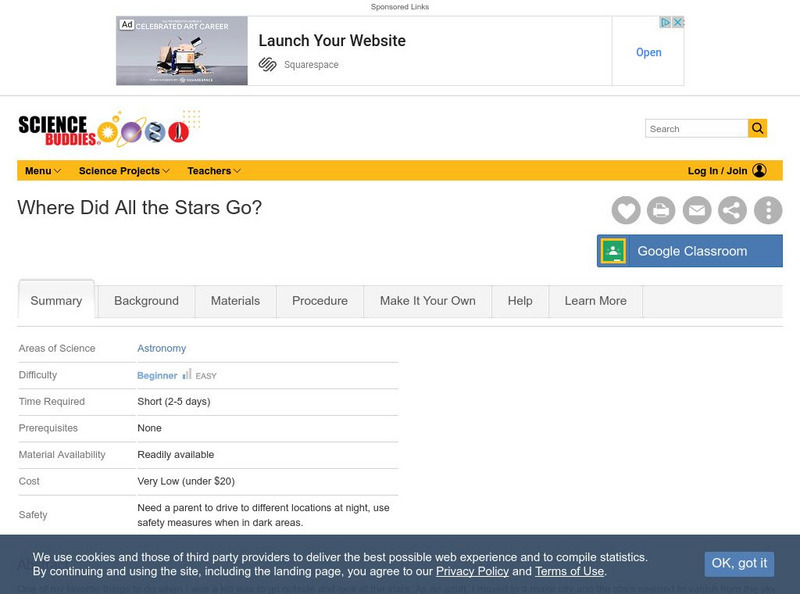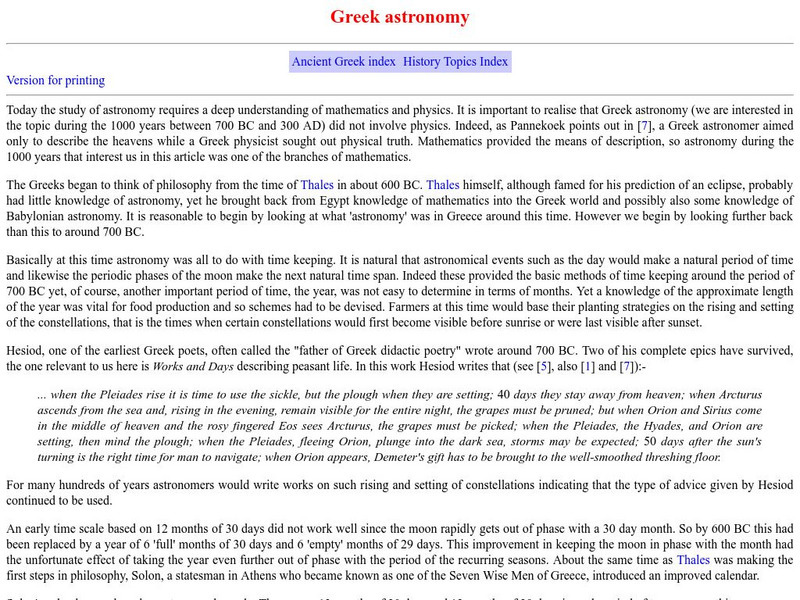Science Buddies
Science Buddies: What Makes the Rings of Saturn?
Saturn is a unique planet because of the many beautiful rings surrounding it. How are all of those rings made? Why is each ring unique?
Science Buddies
Science Buddies: Where Did All the Stars Go?
If you live in a big city or urban area it is hard to see many stars at night. In most urban areas only the most brilliant stars, planets and the moon can be seen. This is because of something called light pollution which is the...
Science Buddies
Science Buddies: The Moon and the Stars
When you are in the city, only a few of the brightest stars are visible. But when you are in the country, you can see many more stars than you can count. Sometimes you can even see the bright belt of our galaxy, the Milky Way. In this...
Other
Science Update: The Science Radio News Feature of the Aaas
Science Update offers daily podcasts to supplement science exploration. Be educated and entertained while learning about astronomy, geology, wildlife, plants, and other science topics. Grab the latest podcasts, or browse the archives by...
California Institute of Technology
Nasa: Infrared Astronomy
A complete, multi-page tutorial on infrared radiation and its importance to astronomical studies.
Other
Aas Science News: Possible Orphan Black Hole
Article reports on the discovery of a supermassive object 90 million light-years from Earth that may be an orphan black hole.
NASA
Nasa: Image Science Center: Ask the Space Scientist
A NASA scientist, Dr. Sten Odenwald, answers many students' questions. Topics include planets, galaxies, black holes, the origin of the universe, and common misconceptions about space.
Other
Saudi Aramco World: Rediscovering Arabic Science
For most westerners, and indeed for many Arabs, the spectacular achievements of Arabic language science from the eighth through the 16th centuries come as a startling discovery, as if an unknown continent had suddenly appeared on the...
Massachusetts Institute of Technology
Mit: Open Course Ware: Hands on Astronomy: Observing Stars and Planets
A university-level course in basic observational procedures in astronomy. Covers how to use a telescope, and includes lecture notes.
Ducksters
Ducksters: Astronomy for Kids: Asteroids
Kids learn about asteroids in the science of astronomy. Large chunks of rock and metal that orbit the Sun including the asteroid belt, Ceres, and Vesta.
Ducksters
Ducksters: Astronomy for Kids: Glossary and Terms
Kids learn about the glossary and terms for the science of astronomy including words and definitions such as asteroid, comet, meteoroid, galaxy, eclipse, etc.
Ducksters
Ducksters: Astronomy for Kids: Comets and Meteors
Kids learn about comets and meteors in the science of astronomy including the coma and tail, meteorites, meteoroids, the Kuiper belt, and the Oort cloud.
Ducksters
Ducksters: Astronomy for Kids: Constellations
Kids learn about the constellations in the science of astronomy. These stars that form patterns when viewed from the Earth have been studied since ancient times.
Ducksters
Ducksters: Astronomy for Kids: Lunar and Solar Eclipses
Kids learn about lunar and solar eclipses in the science of astronomy including the umbra, antumbra, penumbra shadows as well as total, partial, and annular.
Ducksters
Ducksters: Astronomy for Kids: Sunspots, Solar Winds, and Flares
Kids learn about sunspots, solar winds, and solar flares in the science of astronomy. What they are and how they affect Earth.
Ducksters
Ducksters: Astronomy for Kids: The Universe
Kids learn about the universe in the science of astronomy including expansion, size, dark matter and energy, age, and fun facts.
Enchanted Learning
Enchanted Learning: Zoom Astronomy
Where is our Solar System? How far away is the sun? What makes up the sun? Find out all you want to know about our solar system. This is a comprehensive on-line site about space and astronomy. Check out all of the excitement!
Ducksters
Ducksters: Astronomy for Kids: The Planet Uranus
Kids learn about the ice giant planet Uranus of the Solar System including fun facts, mass, day, year, and distance from the Sun. Astronomy for kids and teachers.
Ducksters
Ducksters: Astronomy for Kids: The Planet Venus
Kids learn about the planet Venus of the Solar System including fun facts, mass, day, year, and distance from the Sun. Astronomy for kids and teachers.
Ducksters
Ducksters: Astronomy for Kids: Space Exploration Timeline
Kids learn about the timeline of the history of space exploration including early astronomy, astronauts, spacecraft, planets, and the Moon.
Ducksters
Ducksters: Astronomy for Kids: Stars
Kid's learn about the science of stars like our Sun. Giant hot balls of gas and energy made mostly of hydrogen and helium.
World History Encyclopedia
World History Encyclopedia: Greek Astronomy
Looks at the history of Greek astronomy from the 4th century BC on, and the major figures who contributed ideas. Includes a timeline of Greek science.
University of St. Andrews (UK)
University of St. Andrews: Greek Astronomy
Provides an overview of ancient Greek astronomy and the major figures who played a role in developing ideas about the Universe.
NASA
Nasa: Mission: Science: Electromagnetic Spectrum: Infrared Waves
Infrared light lies between the visible and microwave portions of the electromagnetic spectrum. Infrared light has a range of wavelengths, just like visible light has wavelengths that range from red light to violet.
Other popular searches
- Astronomy and Space Science
- Space Science Astronomy
- Science Astronomy Stars
- Earth Science Astronomy
- Science Astronomy Graphing
- Life Science Astronomy
- "Astronomy and Space Science

























